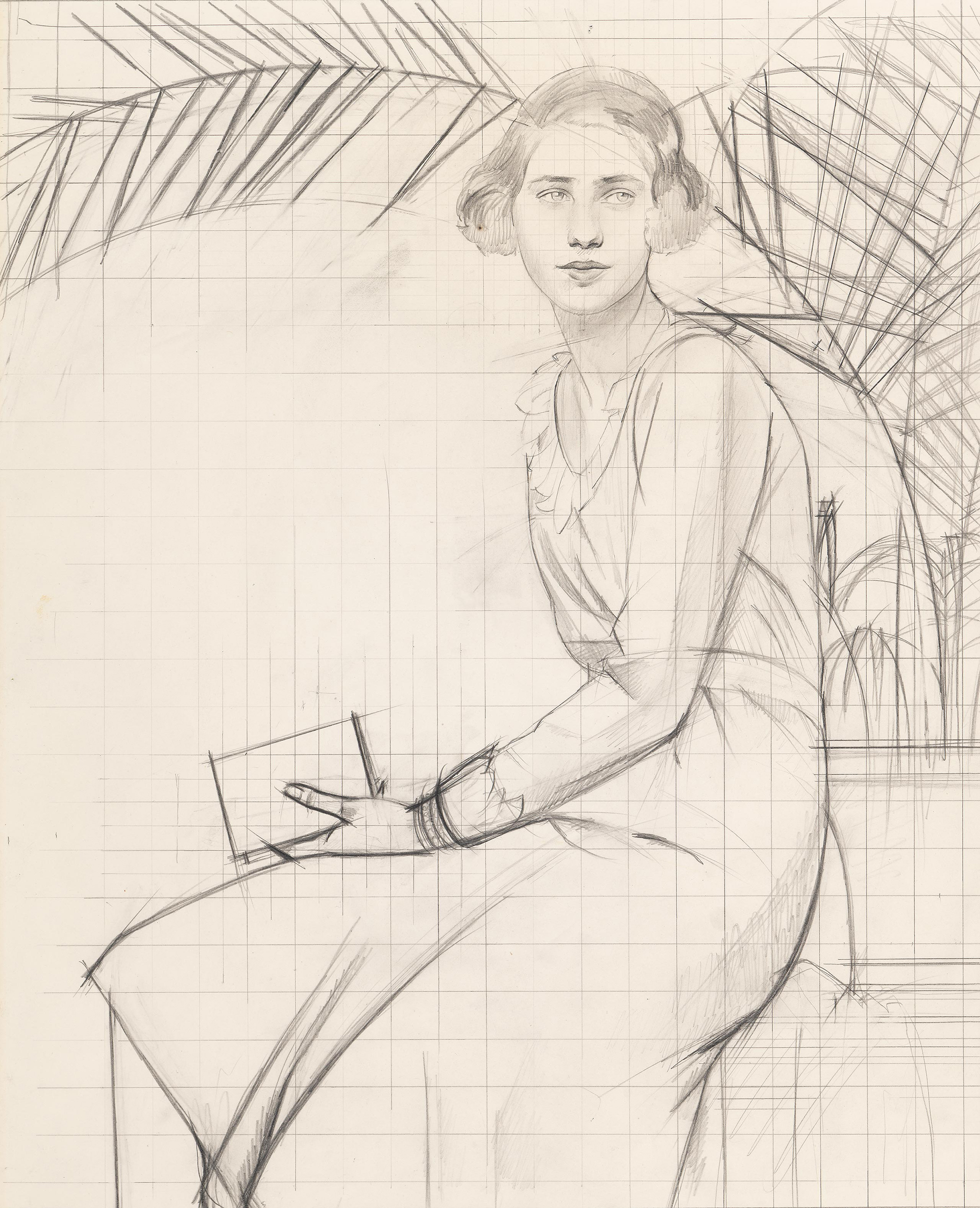
Boutet de Monvel
Bernard
Paris 1881 — São Miguel (Açores) 1949
Portrait of Miss Virginia Thaw
(1911-1997)
Graphite, stumping, squarred.
630 x 481 mm (24 12⁄16 x 18 15⁄16 in.)
Provenance
Barry Friedman Ltd., New York.
A multi-talented French painter and decorator, Bernard Boutet de Monvel was born into an old and very artistic family from Lorraine, which probably explains his innate sense of taste and style. His ancestor, François Boutet de Monvel (1720-1780), a musician and actor at the Comédie Française, was also director of menus-plaisirs for King Stanislas Leszczynski of Poland at the court of Nancy, and his father, Maurice Boutet de Monvel, was a painter and illustrator for children. Bernard trained with painter Luc-Oliver Merson and sculptor Jean Dampt. A close friend of the engraver Eugène Delâtre, he learned etching, in particular the technique of color registration, and by 1912 his etchings were the subject of a retrospective exhibition in Chicago. His painted portraits were just as quickly appreciated. He exhibited at the Salon d’Automne and the Salon des Indépendants, as well as at the Carnegie Institute in Pittsburgh, Pennsylvania, and his style evolved from raw material to precise pointillism, and then to the linear, luminous style that made him so successful. Yet this rectilinear style was not very well received at first: in 1909, his portrait of a dandy on the Place de la Concorde, exhibited at the Galerie Devambez under the name Esquisse for a portrait, worked entirely with ruler and compass, totally anticipating Art Deco painting, was mocked by the critics. Yet Boutet remained true to this new style of extreme sobriety, in terms of both form and color.
Parallel to his artistic experiments, he worked with various magazines, to which he supplied numerous fashion illustrations and cartoons. He collaborated with fashion designer Paul Poiret, for whom he designed models as well as advertising cards and posters. He worked with Lucien Vogel on the Gazette du bon ton and contributed to the Journal des dames et des modes, which resumed publication in 1912. His courage and feats of arms during the First World War earned him the Légion d’honneur and five commendations. In 1917, he was posted to Fez, Morocco, where he took up painting again, executing synthetic, geometric views of the city and its inhabitants. Unlike many Orientalist painters, Boutet did not excessively use bright colors and decorative effects, but focused on tones. These unusual works were exhibited at the Henry Barbazangues gallery in 1925. On his return to Paris, he married Chilean Delfina Edwards Bello (1896-1974) and resumed his activities as a portraitist, particularly of sportsmen and dandies, and as an illustrator of fashion magazines and literary works. He took up decorative painting, working on Jean Patou’s Paris hotel and Jane Renouardt’s villa in Saint-Cloud, among other projects.
In 1926, a retrospective of his work was held at the Anderson Gallery in New York, as was an exhibition of his paintings at the Baltimore Museum of Art in 1927. Quickly emerging as the favorite artist of the American Café society, he portrayed the most prominent families, including the Vanderbilts, the Fricks and the Du Ponts. With the crash of 1929, he received fewer commissions and took more time to focus on urban views, buildings, architecture and bridges. His works in this vein, somewhere between abstraction and photographic realism, place him among the most important Precision painters.
It was at this time, in 1930, when he was at the height of his American popularity, that Boutet painted the portrait of Virginia Thaw (Fig. 1)1 for which this drawing is preparatory. With its precise, geometric line, as if drawn with a ruler and compass, our drawing is the epitome of Boutet de Monvel’s portraiture, whose precision, sobriety, sense of composition and style produce effigies of total elegance. In 1928, Boutet had painted in Paris a portrait of the young woman’s father2, William Thaw III, a World War II pilot and inventor from a Pittsburgh family. Virginia’s world debut, at a ball given by her parents on December 21, 1929 at the Ritz-Carlton, was described in the following day’s New York Times: “The dinner last night, which was for the older friends of the family, was served in the Persian Garden, which like the ballroom suite, had been transformed by Joseph Urban into a summer garden. Golden and peach colored flowers were used to harmonize with the frock of the debutante. Mrs. Thaw and her daughter received the dinner guests in a peach-and- gold drawing room adjoining the Persian Garden on one of the upper floors of the hotel. The tables were under a golden canopy through which gleamed a starry sky. Numerous bamboo trees, hung with illuminated white balloons were grouped about the garden. After dinner the guests descended in a gaily decorated elevator to the ballroom suite and stepped from it to the terrace of a formal garden, abloom with blue, peach and golden-colored flowers.”
The article continues, describing the luxury of the reception rooms and giving the guest list. Here, the young woman is depicted in a very simple dress, black and white on the paint, reputed by family tradition to be a Chanel model, which is perfectly plausible. Her beautiful face and clear eyes stand out against a few palm branches. A photo by George Hoyningen- Huene, a famous fashion photographer, shows her in 1932, seated and wearing a Suzanne Talbot hat (Fig. 2). The pose and geometric effects of the photograph are reminiscent, no doubt coincidentally, of Boutet de Monvel’s drawing, which testifies to his absolute sense of style in the 1930s in both France and the United States, if not to his role in the spread of this style. Virginia Thaw married polo player Rodman Wanamaker II (1899-1976), his fourth wedding.
- Barry Friedman Gallery, Bernard Boutet de Monvel, (catalogue of the exhibition held in New York, 1 November, 1994 – 7 January 1995), 1994, n° 28; Christie’s New York, 10 December 1998, lot 184.
- The portrait came from the collection of Virginia Thaw, who had married polo player Rodman Wanamaker II (1899-1976) who married for the fourth time. The painting was bequeathed to Virgina’s daughter in law, Lynn Wanamaker (1951-2024) married to Francis B. Rice, and finally entered the collection of painter Henry Koehler (1927-2019) sold on 22-23 September 2021 at the Stair Gallery, Hudson NY (lot 44).

